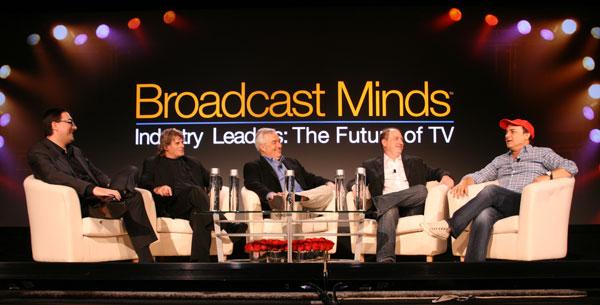NAB 2012: The Future of TV Panel Discussion

All the panelists agreed that the Internet has dramatically changed what they do by enhancing the connection to viewers. Jacobs pointed out that the online component of modern television now goes way beyond marketingit's another channel, and many MTV viewers actually watch on two or more screens simultaneously: TV, laptop, tablet, smartphone.
Of course, the "second screen" is often used for social media such as Facebook and Twitter, which establishes two-way communication between the content provider and consumer. Jacobs cited an MTV show called The Hillswhen it started four years ago, an online aftershow featured five girls dishing on the episode they just watched. Now, the aftershow includes full audience participation via social media.
Similarly, the new paradigm also allows those on the screen to communicate directly with the audience. For example, Chapman said that race-car drivers now tweet during broadcast NASCAR eventsjust not while driving! Television is no longer a monolog, it's a 2-way street.
Fortunately, the rise of the online component does not seem to have threatened the so-called "linear" component from traditional cable and satellite providers. Chapman pointed out that the advertising model still workseven though the online content is often not related to those providers, it promotes their linear service.
One interesting point made by Hawley is that, whereas creativity used to drive people to develop new technology, technology now drives creativity as well. For example, Yamaha sponsors live concert events that are broadcast in the traditional manner, and in addition, a special stream of data is available online that drives any Yamaha Disclavier player piano connected to the streamin essence, the artist is playing your piano in real time.
The bottom line is that television is quickly evolving from a schedule-based, unidirectional process tied to a certain room in the house to an on-demand, interactive activity available any time and anywhere consumers want it. This isn't to say that the linear model is completely deadaccording to Pollack, as many as 100,000 viewers watch his podcast live, even though they can download it any time. Why? He believes it's because people want to be part of a community, citing other examples such as going to the ballpark or a movie theater. And social media such as Facebook, Twitter, and chat rooms only enhance that sense of community and shared experience.
The entire television landscape is shifting rapidly, and it hasn't settled down by any means. So be ready for more upheavals as traditional and non-traditional content providers find their way into uncharted territory.
























































